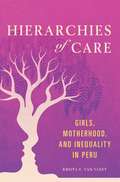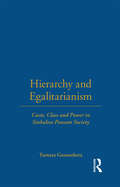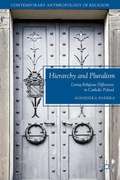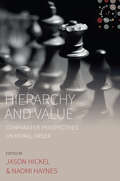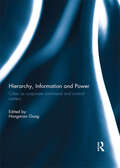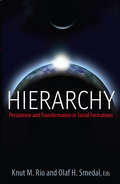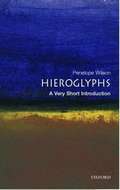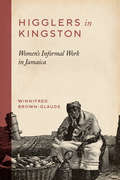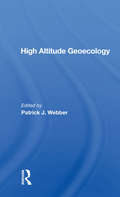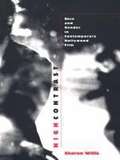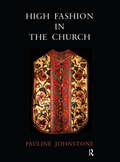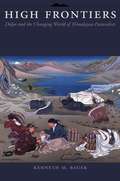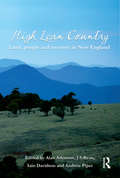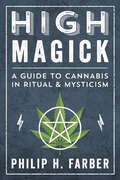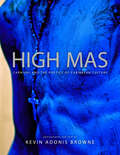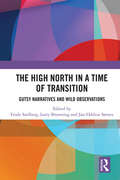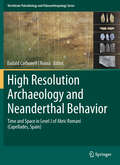- Table View
- List View
Hierarchies of Care: Girls, Motherhood, and Inequality in Peru (Interp Culture New Millennium #1)
by Krista E Van VleetPalomitáy is an orphanage in highland Peru that provides a home for unmarried mothers as young as twelve years old. In their ordinary lives, these young women encounter diverse social expectations and face moral dilemmas. They endeavor to create a ‘good life’ for themselves and their children in a context complicated by competing demands, economic uncertainties, and structured relations of power. Drawing on a year of qualitative on-site research, Krista E. Van Vleet offers a rich ethnography of Palomitáy's young women. She pays particular attention to the moral entanglements that emerge via people's efforts to provide care amid the inequalities and insecurities of today's Peru. State and nonstate participants involved in the women's intimate lives influence how the women see themselves as mothers, students, and citizens. Both deserving of care and responsible for caring for others, the young women must navigate practices interwoven with a range of a racial, gendered, and class hierarchies. Groundbreaking and original, Hierarchies of Care highlights the moral engagement of young women seeking to understand themselves and their place in society in the presence of circumstances that are both precarious and full of hope.
Hierarchies of Power: Evangelical Christianity and Adat Transformation in Indonesian Borneo (Contestations in Contemporary Southeast Asia)
by Imam ArdhiantoThis book focuses on a Pentecostal-Evangelical Kenyah community in central Borneo, a region that crosses the border between Malaysia and Indonesia. The book argues that the Pentecostal-Evangelical (P/e) mode of religious authority and organization has the capacity to adapt to both the pre-existing hierarchical traditional institution such as Adat and modern egalitarian social forms. It has been necessary within the context of Kenyah’s experience of religious change as it enabled many actors from various social classes to obtain and perceive religious authority in a specific local and regional political-religious situation while promoting their identity as egalitarian and autonomous modern subjects. In contrast with other studies on the P/e church that emphasize its egalitarian spirit as a factor that supports its impressive growth, the book contends that its adaptive structural characteristics have enabled the development of this specific Christian denomination to expand rapidly and play a dominant position in contemporary social life in various parts of the world. The book thus provides novel findings in the study of religious change in Southeast Asia by enriching the discussion of historical transformation in the region, and analyzing the articulation of global and regional Christian movements, with the socio-political characteristics of Bornean society.
Hierarchy and Egalitarianism: Caste, Class and Power in Sinhalese Peasant Society (London School Of Economics Monographs On Social Anthropology Ser. #No. 65)
by Tamara GunasekeraA comprehensive analysis of stratification in rural Sri Lanka, taking into account the hierarchies of class, status and power.
Hierarchy and Pluralism
by Agnieszka PasiekaBased on an ethnographic study of rural Poland, this book investigates the challenges of maintaining pluralism in a religiously homogenous society. By examining a multireligious and multiethnic community, Pasieka reveals paradoxes inscribed into the practice and discourse of pluralism.
Hierarchy and Value: Comparative Perspectives on Moral Order (Studies in Social Analysis #7)
by Jason Hickel Naomi HaynesGlobalization promised to bring about a golden age of liberal individualism, breaking down hierarchies of kinship, caste, and gender around the world and freeing people to express their true, authentic agency. But in some places globalization has spurred the emergence of new forms of hierarchy—or the reemergence of old forms—as people try to reconstitute an imagined past of stable moral order. This is evident from the Islamic revival in the Middle East to visions of the 1950s family among conservatives in the United States. Why does this happen and how do we make sense of this phenomenon? Why do some communities see hierarchy as desireable? In this book, leading anthropologists draw on insightful ethnographic case studies from around the world to address these trends. Together, they develop a theory of hierarchy that treats it both as a relational form and a framework for organizing ideas about the social good.
Hierarchy, Information and Power: Cities as Corporate Command and Control Centers
by Hongmian GongThis book is a collection of selected papers presented in the 2012 annual meeting of the Association of American Geographers in New York honoring James O. Wheeler (1938-2010). The eight papers are informed and inspired by James O. Wheeler's many contributions to urban geography, particularly in the areas of urban hierarchy, information flows, cities in the telecommunications age, and cities as corporate command and control centers. They adopt and extend Jim Wheeler’s corporate and/or hierarchical approaches to discuss institutional investment in the U.S., corporate interlocking directorates and fast-growing firms in Canada, corporate intangible assets in South Korea, urban development in Beijing and Macau, and social and cultural diversity of global cities such as New York. Although these two approaches are not the fanciest ones in today's urban geography, they are essential to the understanding of how urban areas are connected and what drives this interconnectedness in this age of globalization. This book was previously published as a special issue of Urban Geography.
Hierarchy: Persistence and Transformation in Social Formations
by Olaf H. Smedal Knut M. RioLouis Dumont's concept of hierarchy continues to inspire social scientists. Using it as their starting point, the contributors to this volume introduce both fresh empirical material and new theoretical considerations. On the basis of diverse ethnographic contexts in Oceania, Asia, and the Middle East they challenge some current conceptions of hierarchical formations and reassess former debates - of post-colonial and neo-colonial agendas, ideas of "democratization" and "globalization," and expanding market economies - both with regard to new theoretical issues and the new world situation.
Hieratic: An Ancient Egyptian Cursive Script (Elements in Writing in the Ancient World)
by Fredrik HagenHieratic was the most widely used script in ancient Egypt, but is today relatively unknown outside Egyptology. Generally written with ink and a brush, it was the script of choice for most genres of text, in contrast to hieroglyphs which was effectively a monumental script. The surviving papyri, ostraca and writing boards attest to the central role of hieratic in Egyptian written culture, and suggest that the majority of literate people were first (and not infrequently only) trained in the cursive script. This Element traces the long history of hieratic from its decipherment in the nineteenth century back to its origins around 2500 BC, and explores its development over time, the different factors influencing its appearance, and the way it was taught and used.
Hieroglyphs: A Very Short Introduction
by Penelope WilsonHieroglyphs were far more than a language. They were an omnipresent and all-powerful force in communicating the messages of ancient Egyptian culture for over three thousand years; used as monumental art, as a means of identifying Egyptianness, and for rarefied communication with the gods. In this exciting new study, Penelope Wilson explores the cultural significance of the script with an emphasis on previously neglected areas such as cryptography, the continuing decipherment into modern times, and examines the powerful fascination hieroglyphs still hold for us today.
Higglers in Kingston: Women's Informal Work in Jamaica
by Winnifred Brown-GlaudeMaking a living in the Caribbean requires resourcefulness and even a willingness to circumvent the law. Women of color in Jamaica encounter bureaucratic mazes, neighborhood territoriality, and ingrained racial and cultural prejudices. For them, it requires nothing less than a herculean effort to realize their entrepreneurial dreams. In Higglers in Kingston, Winnifred Brown-Glaude puts the reader on the ground in frenetic urban Kingston, the capital and largest city in Jamaica. She explores the lives of informal market laborers, called "higglers," across the city as they navigate a corrupt and inaccessible "official" Jamaican economy. But rather than focus merely on the present-day situation, she contextualizes how Jamaica arrived at this point, delving deep into the island's history as a former colony, a home to slaves and masters alike, and an eventual nation of competing and conflicted racial sectors.Higglers in Kingston weaves together contemporary ethnography, economic history, and sociology of race to address a broad audience of readers on a crucial economic and cultural center.
High Altitude Geoecology
by Patrick J. WebberThis book is concerned with section 6 of the United Nations Educational, Scientific, and Cultural Organization (UNESCO) program, "Impact of Human Activities on Temperate and Tropical Mountain and Tundra Ecosystems."
High Contrast: Race and Gender in Contemporary Hollywood Films
by Sharon WillisIn High Contrast, Sharon Willis examines the dynamic relationships between racial and sexual difference in Hollywood film from the 1980s and 1990s. Seizing on the way these differences are accentuated, sensationalized, and eroticized on screen--most often with little apparent regard for the political context in which they operate--Willis restores that context through close readings of a range of movies from cinematic blockbusters to the work of the new auteurs, Spike Lee, David Lynch, and Quentin Tarantino.Capturing the political complexity of these films, Willis argues that race, gender, and sexuality, as they are figured in the fantasy of popular film, do not function separately, but rather inform and determine each other's meaning. She demonstrates how collective anxieties regarding social difference are mapped onto big budget movies like the Die Hard and Lethal Weapon series, Basic Instinct, Fatal Attraction, Thelma and Louise, Terminator 2, and others. Analyzing the artistic styles of directors Lynch, Tarantino, and Lee, in such films as Wild at Heart, Pulp Fiction, and Do the Right Thing, she investigates how these interactions of difference are linked to the production of specific authorial styles, and how race functions for each of these directors, particularly in relation to gender identity, erotics, and fantasy.
High Definition Archaeology: World Archaeology Volume 29 Issue 2
by John A. J. GowlettThe use of modern analyses of high definition data is used to trace relationships or decision paths which could not have been seen with the techniques available 30 years ago. Examples are drawn from a variety of areas and periods.
High Fashion in the Church: The Place of Church Vestments in the History of Art from the Ninth to the Nineteenth Century
by Pauline JohnstoneThis book focuses on second half of the twentieth century, for strange things have been happening in the church. It aim is to show something of the origins and use of the vestments themselves, and to traces the development of their decoration in the context of the arts.
High Frontiers: Dolpo and the Changing World of Himalayan Pastoralists
by Kenneth Michael BauerDolpo is a culturally Tibetan enclave in one of Nepal's most remote regions. The Dolpo-pa, or people of Dolpo, share language, religious and cultural practices, history, and a way of life. Agro-pastoralists who live in some of the highest villages in the world, the Dolpo-pa wrest survival from this inhospitable landscape through a creative combination of farming, animal husbandry, and trade. High Frontiers is an ethnography and ecological history of Dolpo tracing the dramatic transformations in the region's socioeconomic patterns. Once these traders passed freely between Tibet and Nepal with their caravans of yak to exchange salt and grains; they relied on winter pastures in Tibet to maintain their herds. After 1959, China assumed full control over Tibet and the border was closed, restricting livestock migrations and sharply curtailing trade. At the same time, increasing supplies of Indian salt reduced the value of Tibetan salt, undermining Dolpo's economic niche. Dolpo's agro-pastoralists were forced to reinvent their lives by changing their migration patterns, adopting new economic partnerships, and adapting to external agents of change. The region has been transformed as a result of the creation of Nepal's largest national park, the making of Himalaya, a major motion picture filmed on location, the increasing presence of nongovernmental organizations, and a booming trade in medicinal products. High Frontiers examines these transformations at the local level and speculates on the future of pastoralism in this region and across the Himalayas.
High Frontiers: Dolpo and the Changing World of Himalayan Pastoralists (Historical Ecology Series)
by Kenneth Michael BauerDolpo is a culturally Tibetan enclave in one of Nepal's most remote regions. The Dolpo-pa, or people of Dolpo, share language, religious and cultural practices, history, and a way of life. Agro-pastoralists who live in some of the highest villages in the world, the Dolpo-pa wrest survival from this inhospitable landscape through a creative combination of farming, animal husbandry, and trade. High Frontiers is an ethnography and ecological history of Dolpo tracing the dramatic transformations in the region's socioeconomic patterns. Once these traders passed freely between Tibet and Nepal with their caravans of yak to exchange salt and grains; they relied on winter pastures in Tibet to maintain their herds. After 1959, China assumed full control over Tibet and the border was closed, restricting livestock migrations and sharply curtailing trade. At the same time, increasing supplies of Indian salt reduced the value of Tibetan salt, undermining Dolpo's economic niche. Dolpo's agro-pastoralists were forced to reinvent their lives by changing their migration patterns, adopting new economic partnerships, and adapting to external agents of change. The region has been transformed as a result of the creation of Nepal's largest national park, the making of Himalaya, a major motion picture filmed on location, the increasing presence of nongovernmental organizations, and a booming trade in medicinal products. High Frontiers examines these transformations at the local level and speculates on the future of pastoralism in this region and across the Himalayas.
High Heels and Bound Feet and Other Essays on Everyday Anthropology
by Roberta Edwards LenkeitAccording to the author, seeing life through the multifaceted lens of anthropology makes living more rewarding and adds meaning to how we see and experience our world. A committed educator and seasoned author, Lenkeit serves up 22 concise, attention-grabbing essays to demonstrate how core anthropological concepts can be easily applied to everyday life in this highly original, single-authored collection. While the essays focus on cultural anthropology, the inclusion of topics on linguistics, biological anthropology, and archaeology brings attention to the holistic nature of the discipline and contributes to the book's course versatility. All essays conclude with material useful for assimilating content: "Thinking It Through," "Anthropological Terms," and "Thinking Practically." Lenkeit channels Margaret Mead, a major force in popularizing the field and its everyday potential. The lucid, engaging essays in High Heels and Bound Feet will pique readers' interest as they discover how anthropology informs, energizes, and infuses their lives every day.
High Lean Country: Land, people and memory in New England
by Andrew Piper Iain Davidson Alan Atkinson J. S. RyanHigh Lean Country captures the rich history and haunting character of the New England region of northern New South Wales.The authors explore how memory - of land, of family, of patterns of life on the other side of the world - has influenced the identity of New England. They also consider how the high country itself has shaped its people and their sense of regional uniqueness. In doing so, this book sets a new direction for understanding Australia as a whole.Weaving together the histories of human settlement, economic, social and cultural development, as well as interactions with the environment, High Lean Country shows how colonial settlers strived for decades to literally create a new England. It traces the story of the graduates of Oxford and Cambridge who turned their hands to sheep husbandry and developed a squattocracy, the establishment of schools and other institutions, and the cultivation of traditional arts. It also examines the early colonial bushranging period, and a history of not always friendly relations between white settlers and the local Aboriginal population.A project of the Heritage Futures Research Centre at the University of New England, High Lean Country is a fascinating study of this distinctive Australian high country.
High Magick: A Guide to Cannabis in Ritual & Mysticism
by Philip H. FarberPowerful Magick with One of the World's Most Potent PlantsElevate your magical practice with cannabis. Exploring everything from ancient elixirs to modern mystics like Aleister Crowley and Timothy Leary, High Magick is all about using cannabis safely and effectively in spiritual settings. You will find specific ways to use cannabis for:InvocationEvocationBanishingMeditationEnergy healingDivinationScryingChakra ActivationToastingPraisingPathworkingConsecratingChargingWorking with AncestorsMaking Change in the WorldFilled with step-by-step instructions as well as helpful insights into some of the most famous ritual magicians and cannabis proponents in the world, this book helps you harness the spiritual power of this amazing plant. Within these pages, you will also discover how to conduct dynamic rituals like the Talking Joint, the Smoke of Excellence, the Lesser Banishing Ritual of the Leaf, and the Cannabis Magick Holon Ritual.
High Mas: Carnival and the Poetics of Caribbean Culture
by Kevin Adonis BrowneOverall Winner of the 2019 OCM Bocas Prize for Caribbean LiteratureHigh Mas: Carnival and the Poetics of Caribbean Culture explores Caribbean identity through photography, criticism, and personal narrative. Taking a sophisticated and unapologetically subjective Caribbean point of view, the author delves into Mas—a key feature of Trinidad performance—as an emancipatory practice. The photographs and essays here immerse the viewer in carnival experience as never before. Kevin Adonis Browne divulges how performers are or wish to be perceived, along with how, as the photographer, he is implicated in that dynamic. The resulting interplay encourages an informed, nuanced approach to the imaging of contemporary Caribbeanness. The first series, “Seeing Blue,” features Blue Devils from the village of Paramin, whose performances signify an important revision of the post-emancipation tradition of Jab Molassie (Molasses Devil) in Trinidad. The second series, “La Femme des Revenants,” chronicles the debut performance of Tracey Sankar’s La Diablesse, which reintroduced the “Caribbean femme fatale” to a new audience. The third series, “Moko Jumbies of the South,” looks at Stephanie Kanhai and Jonadiah Gonzales, a pair of stilt-walkers from the performance group Touch de Sky from San Fernando in southern Trinidad. “Jouvay Reprised,” the fourth series, follows the political activist group Jouvay Ayiti performing a Mas in the streets of Port of Spain on Emancipation Day in 2015. Troubling the borders that persist between performer and audience, embodiment and spirituality, culture and self-consciousness, the book interrogates what audiences understand about the role of the participant-observer in public contexts. Representing the uneasy embrace of tradition in Trinidad and the Caribbean at large, the book probes the multiple dimensions of vernacular experience and their complementary cultural expressions. For Browne, Mas performance is an exquisite refusal to fully submit to the lingering traumas of slavery, the tyrannies of colonialism, and the myths of independence.
High Minds: The Victorians and the Birth of Modern Britain
by Simon HefferAn ambitious exploration of the making of the Victorian Age—and the Victorian mind—by a master historian.Britain in the 1840s was a country wracked by poverty, unrest, and uncertainty; there were attempts to assassinate the queen and her prime minister; and the ruling class lived in fear of riot and revolution. By the 1880s it was a confident nation of progress and prosperity, transformed not just by industrialization but by new attitudes to politics, education, women, and the working class. That it should have changed so radically was very largely the work of an astonishingly dynamic and high-minded group of people—politicians and philanthropists, writers and thinkers—who in a matter of decades fundamentally remade the country, its institutions and its mindset, and laid the foundations for modern society. High Minds explores this process of transformation as it traces the evolution of British democracy and shows how early laissez-faire attitudes to the fate of the less fortunate turned into campaigns to improve their lives and prospects. The narrative analyzes the birth of new attitudes in education, religion, and science. And High Minds shows how even such aesthetic issues as taste in architecture collided with broader debates about the direction that the country should take. In the process, Simon Heffer looks at the lives and deeds of major politicians; at the intellectual arguments that raged among writers and thinkers such as Matthew Arnold, Thomas Carlyle, and Samuel Butler; and at the "great projects&” of the age, from the Great Exhibition to the Albert Memorial. Drawing heavily on previously unpublished documents, he offers a superbly nuanced portrait into life in an extraordinary era, populated by extraordinary people—and show how the Victorians&’ pursuit of perfection gave birth to the modern Britain we know today.
High Mobility in Europe: Work And Personal Life
by Gil Viry Vincent KaufmannTravelling intensively to and for work helps but also challenges people to find ways of balancing work and personal life. Drawing on a large European longitudinal study, Mobile Europe explores the diversity and ambivalence of mobility situations and the implications for family and career development.
High North Stories in a Time of Transition: Gutsy Narratives and Wild Observations
by Frode Soelberg Larry Browning Jan-Oddvar SørnesThe High North in a Time of Transition collects multiple perspectives on the lives of people in the High North of Norway at a point when the petroleum boom is no longer the dominant cultural feature of the region. Utilizing constructivist grounded theory, the volume contains a rich variety of narrative accounts of fieldwork conducted with those living above the Arctic circle in the city of Bodø. The book will be of interest to scholars from fields including anthropology, narrative theory, and Arctic and Scandinavian studies.
High Performance Computing and the Art of Parallel Programming: An Introduction for Geographers, Social Scientists and Engineers
by Stan Openshaw Ian TurtonThis book provides a non-technical introduction to High Performance Computing applications together with advice about how beginners can start to write parallel programs. The authors show what HPC can offer geographers and social scientists and how it can be used in GIS. They provide examples of where it has already been used and suggestions for other areas of application in geography and the social sciences. Case studies drawn from geography explain the key principles and help to understand the logic and thought processes that lie behind the parallel programming.
High Resolution Archaeology and Neanderthal Behavior
by Eudald Carbonell i RouraThe aim of this book is to provide a new insight on Neanderthal behaviour using the data recovered in level J of Romaní rockshelter (north-eastern Spain). Due to the sedimentary dynamics that formed the Romaní deposit, the occupation layers are characterized by a high temporal resolution, which makes it easier to interprete the archaeological data in behavioural terms. In addition, the different analytical domains (geoarchaeology, lithic technology, zooarchaeology, taphonomy, anthracology, palaeontology) are addressed from a spatial perspective that is basic to understand human behaviour, but also to evaluate the behavioural inferences in the framework of the archaeological formation processes.
